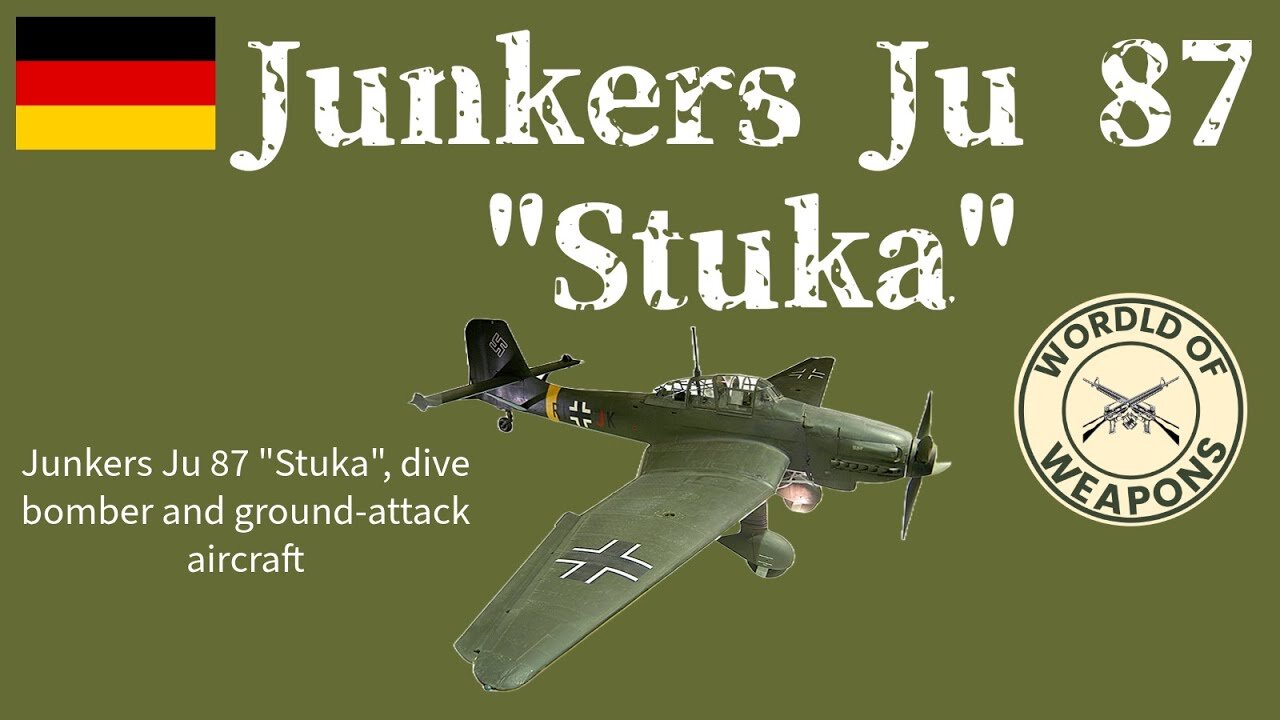Premium Only Content

Ju 87 "Stuka" 🇩🇪 The terror of Europe’s skies
Junkers Ju 87 "Stuka", dive bomber and ground-attack aircraft
1.Introduction 00:00
2.Wings 01:16
3.Weapon System 02:05
4.Engine 02:32
5.Diving procedure 03:45
6.Deployment 06:22
The Junkers Ju 87, popularly known as the "Stuka", from the German word for dive-bomber (Sturzkampfflugzueg), is a German dive bomber and ground-attack aircraft. Designed by Hermann Pohlmann, it first flew in 1935. The Ju 87 made its combat debut in 1937 with the Luftwaffe's Condor Legion during the Spanish Civil War between 1936 and 1939 and served the Axis in World War 2 from beginning to end.
The aircraft is easily recognizable by its inverted gull wings and fixed spatted undercarriage. Upon the leading edges of its faired main gear legs were mounted ram-air sirens known as Jericho trumpets, which became a propaganda symbol of German air power and of the so-called Blitzkrieg victories of between 1939 and 1942, as well as providing Stuka pilots with audible feedback as to speed. The Stuka's design included several innovations, including automatic pull-up dive brakes under both wings to ensure that the aircraft recovered from its attack dive even if the pilot blacked out from the high g-forces, or suffered from target fixation.
The wing was the most unusual feature. It consisted of a single central section and two outer sections installed using four universal joints. The center section had a large negative dihedral (anhedral) and the outer surfaces a positive dihedral.
The offensive armament was two 7.92 mm (.312 in) MG 17 machine guns fitted one in each wing outboard of undercarriage, operated by a mechanical pneumatics system from the pilot's control column. The rear gunner/radio operator operated one 7.92 mm (.312 in) MG 15 machine gun for defensive purposes.
The engine and propeller had automatic controls, and an auto-trimmer made the aircraft tail-heavy as the pilot rolled over into his dive, lining up red lines at 60°, 75° or 80° on the cockpit side window with the horizon and aiming at the target with the sight of the fixed gun. The heavy bomb was swung down clear of the propeller on crutches prior to release.
The Ju 87 operated with considerable success in close air support and anti-shipping roles at the outbreak of World War II. It led air assaults in the invasion of Poland in September 1939. Stukas proved critical to the rapid conquest of Norway, the Netherlands, Belgium, and France in 1940. Though sturdy, accurate, and very effective against ground targets, the Stuka was, like many other dive bombers of the period, vulnerable to fighter aircraft. During the Battle of Britain of 1940–1941, its lack of maneuverability, speed, or defensive armament meant that it required a heavy fighter escort to operate effectively.
Diving procedure:
Flying at 4,600 m (15,100 ft), the pilot located his target through a bombsight window in the cockpit floor. The pilot moved the dive lever to the rear, limiting the "throw" of the control column. The dive brakes were activated automatically, the pilot set the trim tabs, reduced his throttle and closed the coolant flaps. The aircraft then rolled 180°, automatically nosing the aircraft into a dive. Red tabs protruded from the upper surfaces of the wing as a visual indicator to the pilot that, in case of a g-force induced black-out, the automatic dive recovery system would be activated. The Stuka dived at a 60–90° angle, holding a constant speed of 500–600 km/h (310–370 mph) due to dive-brake deployment, which increased the accuracy of the Ju 87's aim.
When the aircraft was reasonably close to the target, a light on the contact altimeter (an altimeter equipped with an electrical contact which triggers at a preset altitude) came on to indicate the bomb-release point, usually at a minimum height of 450 m (1,480 ft). The pilot released the bomb and initiated the automatic pull-out mechanism by depressing a knob on the control column. An elongated U-shaped crutch located under the fuselage swung the bomb out of the way of the propeller, and the aircraft automatically began a 6g pullout. Once the nose was above the horizon, dive brakes were retracted, the throttle was opened, and the propeller was set to climb. The pilot regained control and resumed normal flight. The coolant flaps had to be reopened quickly to prevent overheating. The automatic pull-out was not liked by all pilots.
Physical stress on the crew was severe. Human beings subjected to more than 5g in a seated position will suffer vision impairment in the form of a grey veil known to Stuka pilots as "seeing stars". They lose vision while remaining conscious; after five seconds, they black out. The Ju 87 pilots experienced the visual impairments most during "pull-up" from a dive.
-
 1:42:21
1:42:21
The Quartering
17 hours agoTrump To INVADE Mexico, Take Back Panama Canal Too! NYC Human Torch & Matt Gaetz Report Drops!
166K110 -
 2:23:15
2:23:15
Nerdrotic
16 hours ago $13.78 earnedA Very Merry Christmas | FNT Square Up - Nerdrotic Nooner 453
125K12 -
 1:14:05
1:14:05
Tucker Carlson
16 hours ago“I’ll Win With or Without You,” Teamsters Union President Reveals Kamala Harris’s Famous Last Words
224K377 -
 1:58:31
1:58:31
The Dilley Show
16 hours ago $36.14 earnedTrump Conquering Western Hemisphere? w/Author Brenden Dilley 12/23/2024
166K50 -
 1:09:59
1:09:59
Geeks + Gamers
17 hours agoSonic 3 DESTROYS Mufasa And Disney, Naughty Dog Actress SLAMS Gamers Over Intergalactic
113K21 -
 51:59
51:59
The Dan Bongino Show
18 hours agoDemocrat Donor Admits The Scary Truth (Ep. 2393) - 12/23/2024
931K3.11K -
 2:32:15
2:32:15
Matt Kohrs
1 day agoRumble CEO Chris Pavlovski Talks $775M Tether Partnership || The MK Show
143K36 -
 28:23
28:23
Dave Portnoy
1 day agoDavey Day Trader Presented by Kraken - December 23, 2024
173K44 -
 59:29
59:29
BonginoReport
20 hours agoTrump, Murder Plots, and the Christmas Miracle: Evita + Jack Posobiec (Ep.110) - 12/23/2024
175K153 -
 2:59:14
2:59:14
Wendy Bell Radio
23 hours agoNothing To See Here
137K80